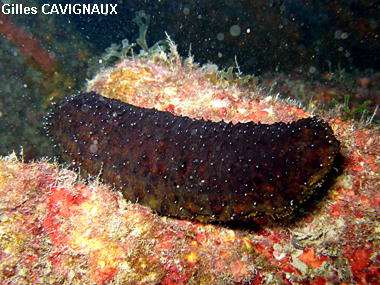| Holothuriidae (sea cucumbers) |
| 25 cm TL (male/unsexed) |
|
benthic; marine; depth range 1 - 125 m |
| Atlantic and the Mediterranean Sea. |
|
Maximum size: 25 cm. Body: with more or less round cross section; ventral face with 3 lines with parapodes with suction cup. Tegument: more fragile constellated with multiple papillae. Color: Brown; papillae, in a variable number, being of beige or white color, at always brown end. The animal is equipped with tubes of Vat which it expels with the least stimulus (Ref. 358). |
| Maximum size: 25 cm. Species presents at all depths. In the event of stimulus by contact, defends itself by expelling its tubes of Vat. Very adherent, they discourage frequently inclinations of the possible attackers or predatory. When the stimulus persist, the animal can go until excreting the whole of its digestive tract. The tubes of Vat and the bodies assigned to digestion are regenerated in the span of a few weeks if the conditions are favorable (Ref. 358). habitat: Hard funds of primary education types and secondary, more rarely in herbarium; very commune in the Mediterranean basin. Nourishes various organic fragments, (charging) literally the elements of the ground in its oral opening; located at the back of the body, using its tentacles oral of flattened form. The animal sorts and introduces the edible organic substances, and rejects the elements not metabolized, particularly sand, in the form of lengthened excrements (Ref. 358). |
|
(LC); Date assessed: 20 May 2010 Ref. 123251)
|
|
|
Source and more info: www.sealifebase.org. For personal, classroom, and other internal use only. Not for publication.

